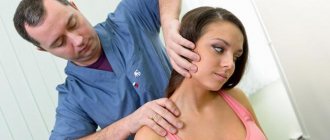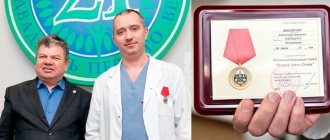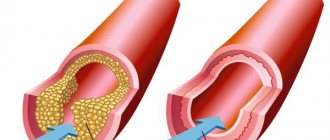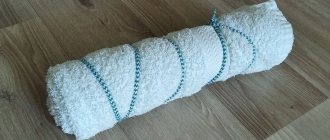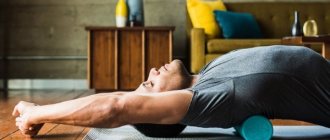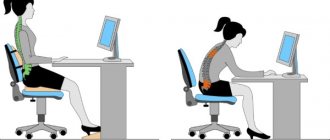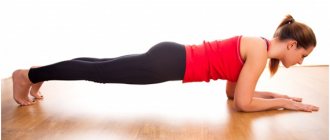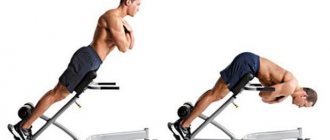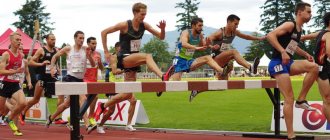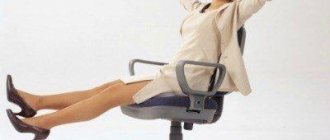Once you master the whole complex, you won’t need medications.
by rehabilitation therapist Alexander Shishonin will help reduce blood pressure and get rid of headaches
— Often, hypertension is a consequence of cervical osteochondrosis, when the first cervical vertebra, the atlas, is displaced and compresses the vessels supplying the brain. The brain receives little oxygen and instructs the heart to increase the strength and frequency of heart contractions. The pressure rises and blood flow to the brain increases. As a result, hypertension develops.
In this case, it is useless to take pills. It is necessary to strengthen the neck muscles in order to eliminate instability of the atlas (less often, of another cervical vertebra) and to free the vessels compressed by the vertebrae and spasmed by the muscles. Then the pressure will return to normal. The simplest gymnastics that you can do at home will help with this.
It's the same with chronic headaches. They are often caused by tension and spasm in the neck muscles. Especially if a person is constantly under stress: he instinctively presses his head into his shoulders to protect himself. As a result, blood microcirculation and nutrition of surrounding tissues are disrupted, intervertebral discs and ligaments are weakened, the vertebrae become unstable and compress the blood vessels.
To understand whether blood flow through the vertebral arteries is impaired, you need to do an ultrasound. If vascular compression is confirmed, you can begin gymnastics.
At first, it is better to practice while sitting in front of a mirror to control every movement.
Three exercises with warm-up and stretching are express gymnastics. The full set contains 12 exercises. You can find them on the website “Club of Former Hypertensive Patients”
You can perform gymnastics every day or every other day. However, if after a month after classes you do not feel significantly better, you should seek professional help. Perhaps the vertebra or vessel is located atypically. This means that a universal option is not suitable.
Popular techniques
Osteochondrosis is a common disease, and therefore there are many techniques for its treatment.
Degree of development of cervical osteochondrosis
Exercise sets are developed by many well-known orthopedists, chiropractors and other specialists dealing with spinal problems. These exercises are based on a basic technique for working the cervical spine, supplemented with various movements to increase efficiency.
Massage after exercise
Self-massage helps relax muscles after exercise.
Photo: Racool_studio - ru.freepik.com Dr. A. Shishonin in his works indicates the need to consolidate the effect of gymnastics with the help of self-massage [7]. This procedure additionally warms up the muscles, improves blood flow and oxygen filling of tissues.
But it is important to remember that massage techniques are contraindicated for patients during a hypertensive crisis - the effect on the muscles activates metabolism, and during the procedure you can get the opposite effect - an increase in blood pressure. Also, massage is contraindicated for people with acute inflammatory diseases, skin pathologies, cancer and a number of other pathologies, so the possibility of performing the procedure is determined only by a doctor [7].
The simplest version of self-massage is tapping your knuckles along the neck, kneading the muscles of the shoulder girdle and neck-collar area. With hypertension, all movements must be directed strictly from top to bottom, otherwise a sharp increase in blood flow in the brain structures can lead to the opposite effect - an increase in blood pressure.
Indications and contraindications for use
Gymnastics is designed specifically for training the muscles in the cervical region. It is usually prescribed by doctors to people suffering from chondrosis, but is also used for other disorders. Indications for prescribing classes include:
Exercises by Dr. Butrimov for the cervical spine
- Compression of the arteries located in the spine.
- Long-term persistent increase in blood pressure.
- Pinched nerve endings in the cervicothoracic region.
- Chronic headaches or migraines.
- Frequent dizziness and weakened blood vessels.
- Deterioration in memorizing new information and decreased thinking ability.
- Poor circulation in the spine.
- Numbness of the upper limbs or loss of mobility.
Exercises will be useful for people with cervical osteochondrosis for complex treatment, as well as for preventive purposes. They will also help get rid of anxiety, mental stress, frequent stress, difficulty concentrating, and hypothermia in the neck.
Exercises according to the Shishonin method can be dangerous for people suffering from pathologies of an infectious nature, or during periods of exacerbation of chronic pathologies. It is also recommended to refrain from exercise during periods of exhaustion of the body, during fever and increased temperature, and bleeding, regardless of the form of localization.
Recommendations
A recording of the author’s performance can be found on the Internet; you can visually study the complex, especially when performing it for the first time. Doctor A.Yu. Shishonin draws attention to the following factors of occupation:
- be focused on gymnastics;
- do not make sudden movements;
- before starting joint gymnastics, you need to warm up the neck muscles by rubbing with your hands;
- take a short break between exercises, watch your breathing. It should be even;
- take your time, perform the complex with pleasure, to melodic music, in order to get satisfaction from the exercises;
- be consistent in neck exercises;
- accompany the exercises by monitoring correct posture and shoulder position.
The main differences between Shishonin gymnastics
What is the reason for the high effectiveness of Shishonin’s gymnastics? Unlike other methods based on physical exercises, this gymnastics is less traumatic and easy to perform even with severe damage to the vertebrae, when any movement causes excruciating pain. All exercises included in the treatment complex are performed very slowly and do not require much effort. The classes do not require any exercise equipment or sports equipment, and the surrounding conditions do not matter. You can practice in any room and at any time when you have 10-15 minutes free.
Shishonin gymnastics can be performed both at home and in the office
The complete complex consists of three parts:
- warming up the neck muscles;
- basic exercises;
- self-massage.
The best result is achieved by the full complex, but if for some reason it is not possible to devote more time to classes, the main emphasis is on exercises. At an early stage, such gymnastics allows you to completely restore the health of the spine, but in a more severe form you can only reduce symptoms and alleviate the patient’s condition.
The main emphasis is on basic exercises aimed at working deep and superficial muscles.
Important! Shishonin’s gymnastics are indicated not only for osteochondrosis, but also for a number of other diseases: intervertebral hernia, spinal curvature, hypertension, migraines, insomnia. As a preventive measure, it is recommended for sedentary work and a sedentary lifestyle, as well as for people exposed to psycho-emotional stress.
Benefits of Shishonin gymnastics
Basic set of 7 exercises
Stand next to a wall or sit on a chair. Slowly tilt your head towards your left shoulder, freeze in this position for 15-20 seconds. Repeat the movement to the right shoulder. When bending over, there may be slight pain in the neck. There is no need to stop practicing. If the pain is unbearable, then classes should be stopped.
- Metronome. Sitting on a chair, place your hands on your knees. Then lower your arms, move them back a little, pull your head up, and freeze for 30 seconds. Return to starting position
- Heron. Stand up straight. Stretch your neck forward so that your chin remains parallel to the floor (do not raise or lower it). Then turn your neck to the left side, slowly lower it to your shoulder, return to the standing position. Repeat to the right side.
- Goose. Repeat the previous movement, only when you tilt your head towards your shoulder, hold for 30 seconds. If you feel pain, then 10 seconds is enough. The load should not be painful.
- A look at the sky. Extend your head as far as possible. Rotate your neck toward your right shoulder and hold for 30 seconds. The main thing is that there should not be severe pain. If you feel discomfort, turn your head until the pain becomes slight, the load should be gradual.
- Frame. While sitting on a chair, place your right hand on your left shoulder. Raise your elbow parallel to the floor. Place your left hand on your knee, turn your neck to the right side and fixate for 30 seconds. Repeat the movements in the other direction.
- Fakir. Bend the raised ones slightly at the elbows, then clasp them overhead into a lock. Turn your head one way or the other, hold for 30 seconds.
- Spring. Sit up straight, tilt your chin slightly, stay in this position for 4-6 seconds. Raise your head smoothly, pull your chin first forward and then upward.
You can also watch how to do the exercises correctly in the video:
Sources
- Clinical guidelines “Arterial hypertension in adults.” Russian Society of Cardiology
- Hypertension. WHO
- Algorithms for managing a patient with hypertensive crisis. All-Russian public organization “Promoting the prevention and treatment of arterial hypertension “Antihypertensive League””.
- Bismak E.V. The effectiveness of using physical rehabilitation means for stage I-II hypertension at the outpatient rehabilitation stage. Phys. education of students creative specialties. — 2008. — No. 3. — P. 9-15
- Algorithms for managing a patient with arterial hypertension and hypertensive crisis. Russian Society of Cardiology
- Gymnastics for hypertension. Clinic of Dr. Shishonin
- Shishonin gymnastics for the neck with cervical osteochondrosis. ANO "Central Clinical Medical Unit"
- Correct breathing for arterial hypertension according to the method of Dr. Shishonin. Shishonin portal. Be healthy with Dr. Shishonin!
For whom exercise is contraindicated?
There are no absolute contraindications for therapeutic exercises; there are temporary restrictions related to the patient’s health condition. Much depends on the intensity and duration of exercise: in some cases, only minimal loads are allowed and exercises are performed under the supervision of a doctor. So, charging is not assigned if:
- there are soft tissue or vertebral injuries, spinal cord tumors;
- osteochondrosis is in the acute stage and is accompanied by severe pain;
- there are problems with the vestibular apparatus.
In case of cardiovascular diseases, severe forms of diabetes, or the presence of osteophytes in the spinal region, exercise should be done with caution and only under the supervision of a specialist. If the vertebrae are unstable, exercises should be performed in a special soft collar, which will prevent displacement. Other diseases are not an obstacle to exercise therapy, although this must be determined by the attending physician in each specific case.
It is better to consult your doctor about the need for exercise after a complete examination.
Orthopedic soft collar
Basic rules for performing the complex
Before you start performing physical therapy exercises, you need to familiarize yourself with the basic basic rules:
Can cervical osteochondrosis cause high blood pressure?
- the exercise itself is performed 1.5-2 hours after finishing the meal, not earlier;
- before performing the exercises, the cervical area and the back of the head are pre-warmed with light, slightly massaging circular movements;
- physical activity should increase gradually - for the first 7-10 days it will be enough to do 3-4 exercises from the seven described below;
- Regularity is important - in the first week you should do gymnastics daily so that the body can get used to physical activity, later it is recommended to reduce the exercises to three times a week;
- during gymnastics, you need to keep your back straight and your head level; the exercises themselves should be performed slowly and carefully, since quick jerks will not lead to a good result, but will only aggravate the situation.
No ads 2
The benefits of Shishonin exercises
- Strengthening the muscles in the neck and chest;
- Improving cerebral blood supply;
- Getting rid of stiffness and muscle spasms;
- Getting rid of hypertension, headaches, insomnia and other manifestations of cervical osteochondrosis.
As the complex is completed, the person’s ability to work returns, it is easy for him to live and move.
Therefore, we urgently need to take care of our health! The good thing about gymnastics is that it can be performed even at work and for preventive purposes.
How to improve cerebral circulation
Chronic cerebrovascular accident is a direct path to stroke. It is fraught with other unpleasant consequences: memory impairment, deterioration in performance, dizziness and fainting, numbness of the face.
Here are 5 exercises to improve cerebral circulation:
- Birch. A universal pose to improve blood flow throughout the body, including the head. You need to start from a minute, gradually increasing the time.
- Tilts in all directions and rotation of the head. Movements should be smooth. Do not overdo it, if your eyes darken or you feel dizzy - reduce the range of movements after a 5-minute break.
- Stand with your back to the wall, inhale and press hard against it, tensing your neck muscles. Hold for 5 seconds, relax.
- While sitting, press your forehead with your palm and tense your neck muscles, not allowing your head position to change. Hold the position of holding your breath for 5-10 seconds, exhale, relax. 4-7 repetitions are enough.
- While sitting at the table, rest your elbow on it. Press your palm to your temple. Tilt your head towards your hand, resist with your palm. Keep the muscles tense for 5-10 seconds, then repeat on the other side.
Conservative treatment for hypertension
To normalize high blood pressure, doctors select drug treatment for patients with hypertension. First of all, the specialist should prescribe a drug from the group of antihypertensive drugs or even a combination of several medications - the choice depends on age, the degree of increase in blood pressure and the stage of the disease.
There are 5 main classes of drugs against hypertension; they are aimed at blocking certain enzymes, ions or receptors of biologically active substances that are involved in the pathogenesis of increased blood pressure. Also included in the list of “first-line” drugs are diuretics - diuretics reduce the volume of blood, as well as intercellular fluid, which reduces the load on the heart and stabilizes pressure in the blood vessels.
It is important for patients to adhere to the rules for treating hypertension, which are relevant in all situations, regardless of the medications prescribed:
- carry out all medical prescriptions;
- Constantly carry out self-monitoring of blood pressure;
- take medications regardless of the numbers on the tonometer - therapy for hypertension is permanent;
- Do not stop taking medications or change dosages on your own [5].
Self-monitoring your blood pressure helps you avoid serious problems caused by hypertension.
Photo: prostooleh - ru.freepik.com Correction of hypertension is not limited to the use of antihypertensive drugs and includes lifestyle changes, stress management and physiotherapy treatments. Therapeutic exercises are also included in the list of mandatory activities for hypertension - special exercises have a multifaceted restorative effect on the body of such patients [4].
How to measure blood pressure using a mechanical tonometer
In order to measure pressure with a mechanical tonometer, you need:
- sit in a comfortable position and relax, while your arm should be bent at the elbow joint and lie on a flat surface,
- remove the shoulder part of the arm from clothing and fasten the cuff on it (its lower edge should be 3-4 cm above the elbow bend),
- place a stethoscope (phonendoscope) on the inside of the elbow joint in the place where the pulse can best be felt,
- using a hand pump, start pumping air into the cuff,
- bring the pressure gauge needle to values exceeding the expected pressure by 30-40 mm. rt. Art. (for example, if the patient’s normal blood pressure is 135/90, then you can stop at 170),
- slowly release air from the cuff, waiting for tones to appear - these are the sounds of a heartbeat; their appearance marks the boundary of systolic pressure, and their disappearance marks the boundary of diastolic pressure. Simply put, if tones appeared at number 150 and disappeared at number 100, then the result is 150/100).
An automatic blood pressure monitor is easier to use (you don’t need to listen to your heart rate yourself), but it is less accurate. Such devices operate on batteries or from the mains.
